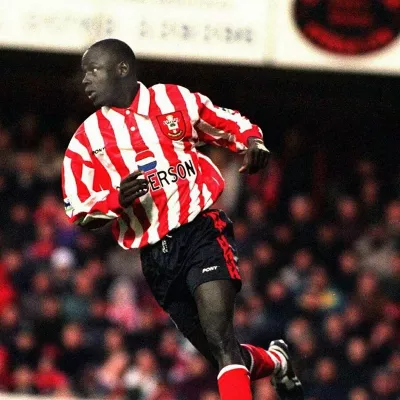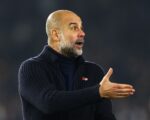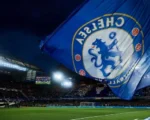
Ali Dia And The George Weah Hoax
Whenever the subject of worst signings in Premier League history comes up, you can be sure that one name always comes up. That name is Ali Dia, the man, the myth, the legend that only ever made one appearance, yet is still usually the one agreed as the worst of all time. Despite joining Southampton on a free transfer, there is a very good reason to believe that he is the worst, especially for those Saints’ fans who were there to witness his one and only game. Despite his legendary status, he has pretty much disappeared into the ether since his moment in the spotlight, but his story still bears telling. Also I have to give credit to Bleacher Report, who did two follow up articles on Dia, one in 2015 and one in 2016, where they managed to track him down and unearthed a large portion of the information which is now publicly available regarding Dia.
Born on the 20th August 1965 in Senegal, Ali Dia is actually Aly Dia, which probably goes a long way to explain his ability to vanish from the public spotlight. Even though he was recorded in records kept by the English FA and other football associations as Aly Dia, somehow his name became reported as Ali in the English press. Aly was the son of a diplomat father and school teacher morther, who had 6 children in total. When his father was transferred to the Senegalese embassy in Paris, the family went with him and there, expressly against the wishes of his parents, Aly put his efforts into making a career as a professional footballer. His parents, particularly his mother, wanted him to concentrate on his education but Aly, like so many kids, just wanted to play football. To that end he joined a lower league semi-professional team in France, AS Beauvais in 1988.
After a largely unsuccessful, and brief, spell with Beauvais, Dia moved to Cercle Dijon, then ES La Rochelle and Saint-Quentin, who released him. After a while without a club, Dia signed a deal with AL Chateaubriant. The contract paid him 3,030 francs per month to work with the club’s youth team 87 hours a month and to play for the club. According to club chairman Michel Bonnier, Aly played regularly for the A and B teams in the 1993/4 season. It was not enough to satisfy Aly and he handed in his 3 month’s notice in August 1994 to find another club, moving to Avignon initially.
He resurfaced the following year in Finland, signing for FinnPa (Finnairin Palloilijat – I will stick to FinnPa!) in Helsinki after using something that was to become his modus operandi. Yes, he had begun using the name of legendary African striker George Weah to open doors and get him a big contract. FinnPa were a minor team that had been set up by workers at a Finnish airline. Despite receiving modest financial backing from the airline, the club were not rich by any means and Dia, due to his ‘pedigree’ was one of the club’s highest earners on around £250 per week. They pushed the boat out for their new star, naively believing that he had been recommended by the great George Weah, so must be good. He was picked up at Helsinki Airport on arrival by teammate Simo Valakari, who also worked part-time in the club’s back office. Initially the club put him up in a hotel room, but he ran up a large mini-bar bill so they quickly rented a flat for him to stay in.
“Yes, he was telling those stories [about George Weah] then.” Finnpa teammate Kelle Lehtinen.
He made his debut in the first round of league matches, with just 8 minutes to go in a 0-0 draw away to Haka. Aly made no impact. It was a while before he played again, no doubt down to his lifestyle and attitude if Valakari is to be believed: “When Ali arrived, he had something. With the outside of his right foot, he could go round a defender. But that was all he had. After the first two weeks, bam, it was gone. Maybe it was the parties or something, but then he looked like he had never played football at all.” It was not until the 6th round of matches that Dia got back on the pitch for FinnPa, once again as a substitute, this time in the 74th minute with the team leading 2-0 away at VPS. They ran out 3-1 winners but Dia once again failed to impress. It got worse for him when he finally got to make a start for the team on 15th June 1995, at home to Ilves. Aly played the full 90 minutes but according to a report in Finnish newspaper Helsingin Sanomat, Dia was caught offside 10 times and spent most of the game ruining his own team’s attacks! FinnPa lost 3-1. Probably unsurprisingly.
Despite that poor performance, Aly started the following match away to FC Jazz. He was taken off a minue after half-time after a performance described by the newspaper as “invisible”. He made his fifth, and final, appearance for FinnPa in the 10th round of games, coming on in the 81st minute. In early July 1995, despite having just 13 fit players at training ahead of an important match at Mikkelin Palloilijat, there was no sign of Dia reported Helsingin Sanomat: “Some of the players are being taped on the physio’s table, and slowly FinnPa’s situation is being revealed in all of its ugliness. One wonders where is French striker Aly Dia?” The club’s manager told the paper that he had gone to either France or Senegal for his mother’s funeral and was meant to have returned that day, but there was no sign of him. Aly’s mother was very much alive and well then. Due to his disappearance, Valakari was sent round to the flat that Dia had been provided with the spare key: “When I opened the door, I could not believe what I saw. It was like a hurricane had gone through the flat.” FinnPa folded in 1998 after relegation due to unsustainable debts, in part due to the bills run up by Dia during his time at the club.
Dia had simply moved to northern Finland to sign for PK-35 in the second tier Eastern Division. According to former team-mate Toni Korkeakunnas, Aly just turned up and started telling people the George Weah stories. This was a slightly more successful spell as Dia managed to score one goal in his three appearances. He was already on the move again by autumn 1995, turning up at VfB Lubeck, who had just been promoted to the second Bundesliga. Head coach Michael Lorkowski put the blame at the feet of the club’s general manager Helmut Schulte, who Lorkowski claims was completely taken in by the Weah connection. Whatever the reason, Aly was given a trial and scored 5 games in the match, making a link to Weah seem somewhat believable. Lorkowski was taken in by the goals and selected him for matchday 5, bringing him off the bench in the 73rd minute at Hannover 96. The game ended 0-0. He was given a second chance on matchday 7, with Lubeck trailing VfB Leipzig 1-0. Dia was brought on in the 62nd min but the game ended 2-0 to Leipzig. Lorkowski said that the trial must have just been “his lucky day” and that later he was incredibly bad. It was at that point Dia left Germany to try his luck in England.
It is not until October 1996 that Aly resurfaces, when he plays a game for Rotherham United, on the 8th of the month, after telling them that he was a Senegalese international. Though he was honest about having been with Lubeck the previous season. He played for their reserves against Stockport County reserves in a 2-1 defeat and was taken off after failing to impress. He was not going to let a little setback like that stop him and so it was that Harry Redknapp began to receive phone calls at his training ground regarding a free agent Senegalese international: “I keep getting phone calls at the training ground from a guy called ‘Georgie Weah’,” recalled the then West Ham United manager. “Lovely George, you wanna play for West Ham?”
“No, I have another player for you. My cousin, Ali Dia.”
“This is a wind up.” And with that, Redknapp hangs up. It can be difficult to spoof a spoofer!
That same day, Gillingham manager Tony Pulis did take the bait: “I was shocked to receive a call from someone claiming to be George Weah, recommending a friend of his. I wouldn’t have thought a man like Weah would have heard of Gillingham, but we gave the lad a trial and he was rubbish.”
Undeterred, Aly managed to get himself a shot at non-league side Blyth Spartans, who were managed by Peter Harrison at the time. Harrison was later to become a notorious football agent. On 9th November 1996 Aly Dia became the first black footballer to play for Spartans, coming on as a sub against Boston United. Then he once again did a vanishing act. Blyth’s media manager Phil Castiaux later told Bleacher Report that, “he simply turned up at Southampton without us knowing.”
Southampton at the time were managed by Graeme Souness, who had left Turkish football behind following the flag planting furore. A legend of the game as a player, it would probably not occur to Souness to question that Weah, the reigning World Player of the Year at the time, might call him personally to recommend his cousin. Saints were also desperately short of attackers at the time, so when the caller told Souness that his cousin, Aly Dia, was looking for a club, had 13 caps for Senegal and had previously played for Paris Saint Germain, Souness did not investigate the claims. Which was lucky for Dia as he had never played a single minute for his country. Instead Souness said: “He’s played with George Weah at Paris Saint-Germain, and last year he was playing in the second division in Germany. We’ve said, come down and train with us for a week or so and see what’s what … When someone like that gives you a recommendation you tend to sit up and take notice.” Aly was given a 1-month deal to prove himself and international clearance was applied for, so that he could play in England. Souness later revealed that Eyal Berkovic had joined the club in a similar way, joining for a week in pre-season and ended up signed, later moving on to play under Redknapp at West Ham.
The international clearance came through on 17th September 1996, making Dia finally eligible to train with the team. Initially the plan was to give him a run out in a reserves game during the week to have a proper look at him, but bad weather forced the abandonment of the game and so it was that Aly just trained with the first team properly on the Friday before the Saints’ next Premier League match on Saturday. Dia had managed to find time to boast about his exploits with Weah at PSG and his friendship with David Ginola, only for one of the Southampton team to call his bluff. He had played alongside Ginola before and called up the Frenchman, only for Dia to vanish when Ginola answered the call.
There were more warning signs with Egil Ostenstad saying: “We started training, and everyone quickly realised he wasn’t quite as good as George Weah. It was easy to see that this guy had never been close to the top level in football. He was very, very poor. It wasn’t just because he had a bad day either.” He also failed to impress Soton’s star man Matt Le Tissier: “I only really trained with him once, on the Friday before the fateful day. He joined in the five-a-side on the Friday morning, and was introduced to us as a trialist. I remember at the time thinking: ‘He’s not very good. He’s probably not going to make it.'”
Despite the warning signs, Souness was desperate enough to include him in the squad for the weekend’s Premer League game and told Sky Sports at the time: “We’ve had this lad training with us for a week and he’s shown in training that he’s lively and sharp. We intended to play him in a mid-week reserve game against Arsenal’s reserves but couldn’t because the weather was so bad we couldn’t get him on.” The choice to pick Dia had caused a surprise among local reporters, with Graham Hiley, then at the Southern Daily Echo as a young reporter, saying: “I watched him in training, and I remember thinking he would not be signed as he did not look good enough and thought no more about him until I got to the ground. A fan told me he was on the bench, and I could not believe it. I felt really bad as I had not even put him in the squad, but then it never occurred to me that I should.”
Le Tissier later admitted he was just as surprised to find Aly in the changing room before the game, with a later account that he had clearly embellished: “He came to training and trained with us for a couple of days, and it was quite odd. I was thinking, ‘what’s he doing here?’ I honestly thought he’d won a competition. We turned up the next day for the game, sat in the dressing room at 1:45pm and this guy sat in the dressing room! I was sitting thinking, ‘wow that’s some competition he won. Not only did he get to train with us, he’s going to hear the team talk and everything!” But still, it was not really an issue as the team still had Le Tissier, Dia was only on the bench as a precaution.
Souness later said: “So this guy turns up, and anyone who’s been involved in football, you know in the first five minutes of a game – even if it’s a small five-a-side – if the boy can play or not. So, within the first five minutes on a Monday morning, we said he wasn’t for us. He was hopeless. But we didn’t have enough players to have an eight-a-side. So we kept him for a week, and as the week went on, we had more and more players that got injured. We were playing Leeds United on the Saturday, and Matt was our only fit forward. It’s all Matt’s fault because he only lasts for about 20 minutes! I was looking at the bench thinking, ‘what could we do?’ We had a centre-half, a right-back, and a left-back. Terry Cooper (Southampton’s chief European scout) had told me in the week ‘you’re going to have that fool on the bench’ as we didn’t have any other striker. So we ended up putting him on the bench and the worst-case scenario would be that he would come on, run around, and be a pest.”
Unfortunately, there was an issue that no one at the club knew about. Le Tissier had stayed behind after training on the Friday to practice penalties and had tweaked a muscle in his thigh after hitting a few. The England international had not told anyone, knowing the injury situation at the club he had not wanted to cause a panic. And so it was that the 23rd November 1996 rolled around and Aly Dia was on the bench for Southampton as they faced Leeds United in the Premier League. Souness’s big fear came true after just twenty minutes as Le Tissier went down injured and, despite treatment and trying to run it off, was unable to continue. It was Aly Dia’s big moment and, in the 32nd minute, wearing the number 33 shirt, Aly Dia ran onto the pitch as the replacement for club legend Matt Le Tissier. To say that it did not go well is an understatement, though he did manage to hit a post. Le Tissier said: “He ran around the pitch like Bambi on ice. It was very, very embarrassing to watch. We were like: ‘What’s this geezer doing? He’s hopeless.’ Graeme named him as a sub and we couldn’t believe it. I got injured after 20 minutes and when I saw him warming up, I’m going: ‘Surely not?’ Graeme put him on and he was fucking hopeless, so he took him off again. It was crazy.” Dia was so bad that Dutch defender Ken Monkou replaced him in the 85th minute as Saints slumped to a 2-0 loss.
The Sunday Mirror said in their match report: “Souness surprisingly brought on Senegal international Ali Dia for his Premiership debut after the player had been at the club on trial for only a week. But Dia, a close friend of AC Milan superstar George Weah, missed a golden chance with his first kick and was substituted himself late in the game by Ken Monkou.” The Guardian quoted Souness as saying: “It just goes to show the state of things at the club at the moment that a player I have never even seen [Dia], let alone watched playing in a game, was able to play in the Premiership.” Even more damning was Souness post-match verdict in the media press conference: “I sent him on today having never seen him play Premiership football. But I do not have any strikers. Am I enjoying this? Do you enjoy a kick in the bollocks?”
None of this seemed to have reached The Independent, who flagged him up as a player to watch on the 25th November: “Watch out for… Ali Dia (Southampton). At 30 years old, the out-of-contract former Bologna striker – the first-half substitute for Matt Le Tissier on Saturday – may have much of his career behind him, but his arrival at The Dell comes on the personal recommendation of George Weah, a former team-mate at Paris St-Germain.”
Southampton had already decided enough was enough and, just 14 days into his contract, Aly Dia was released. The Saints’ director of football at the time, Lawrie McMenemy saying: “He came on and clearly wasn’t up to the standard – and we let him go the next week.” Souness later admitted that Dia had earned £2,000 for his two weeks at Southampton. For most of us, that is where the Aly Dia story ends, but there was still mileage in the George Weah’s cousin con and next up to fall for it was Port Vale, as their secretary Bill Lodey later said: “He was recommended to us by someone very important and he played one reserve game against Middlesbrough. To be honest he didn’t impress, and we last heard of him at Rotherham.” Dia had played on trial for Vale, scoring both their goals in a 3-2 reserve team defeat against Sunderland, but failed to get a contract.
Aly was not yet ready to give up and he contacted Peter Harrison, the Blyth Spartans manager, who also ran a business called Activity Sportswear and worked as an agent as well. When Gateshead manager Colin Richardson called in to Activity looking to buy some training tops, Harrison offered him a little extra bonus to go with the clothing. At the time, Gateshead were struggling in the GM Vauxhall Conference (England’s 5th tier at the time), having not long won promotion to the division. This was despite having Bryan Robson’s two younger brother, Gary and Justin, in their team. They desperately needed a boost, perhaps an African international striker boost? Gateshead chairman John Gibson revealed in his column for The Chronicle in 2014: “I spoke with my manager and a couple of other directors, then – deciding no one could take Dia at his word – I phoned the police on the south coast and the hotel where our intrepid international footballer had hung his hat. There had been a whisper Ali had made a quick getaway in his car and that his hotel bill had remained unpaid. Anyway, we got all that sorted and decided that on a match-to-match basis we couldn’t lose.” Less than a month after his Premiership debut, Aly Dia signed a deal with Gateshead that would run until the end of the season. He received a £1,500 signing fee, plus he also was given a similar contract to Gary Robson, who had joined Gateshead with almost 300 appearances in the English Football League under his belt – around £400 a week.
He made his debut in a 5-0 win over Bath City on 13th December 1996, scoring and, according to the Gateshead Post’s match report: “Dia showed good pace and marked his debut with a late goal having already provided the assist for Paul Thompson to register his 13th goal of the campaign.” The post rated him as 7 out of 10.
The following day, the national media revealed Dia’s con as the Sunday Mirror reported on how he had used the Weah trick on Port Vale, Bournemouth and Gillingham. Souness said on learning about being conned: “I don’t feel I have been duped in the slightest … because that’s the way the world is these days. It cost us a couple of grand for two weeks wages. It’s not broken our hearts – and we certainly don’t feel hard done-by. He was an international player so we gave him a go, but he didn’t impress and has now left the club.” However he was not an international, though the Senegal football federation had refused to supply information about his record to the Mirror. Weah had been contacted and said quite categorically that he did not know anyone called Aly Dia, nor had he ever spoken to Souness.
A few days later The Guardian reported on the Weah hoax, but they continued to post the myth that he was an international, reporting on the 16th December: “He has played 13 matches for Senegal and scored five goals.” Dia tried to bluff his way through it all saying: “I do know George Weah, but I’m certainly not his best mate.” Aly then recounted a conversation that he had with Souness: “He told me that George rang him and said that I’m a good player. I’m not afraid to say that: ‘I’m a good player, I can prove that.” When pressed by the journalist to confirm whether or not Weah had called Souness, Dia replied: “Personally, like I told you, I don’t really know.”
On the 20th December, Dia played for Gateshead and shrugged off the Mirror story in an interview with the Post, which called the expose “false allegations” and then went on to say that Dia had recently scored for Senegal in a 3-1 1998 World Cup qualifying win over Guinea. Unfortunately for the Post, Senegal had not played Guinea, nor had they reached that stage of World Cup qualifying as they had been knocked out in the first round of the qualifiers by Togo. Aly told the Post: “I have been portrayed as a con man and a poor player, but I am neither and intend to prove people wrong. Obviously I’m disappointed not to have made it in the Premiership, but I’ve got faith in my own ability and my only concern now is Gateshead. My contract is just until the end of the season. But if things go well, who knows, I could stay longer.”
After the excitement of his debut, things on the pitch were not going well for Aly once more as his level dipped. He started the next two matches but failed to score against Hednesford and Stalybridge and Gateshead were stuck in a relegation dogfight. He made a fourth appearance for Gateshead, playing the full 90 minutes at home to Halifax, missing two good chances and failing to score as Gateshead lost. Colin Richardson kept faith in his Senegalese ‘international’ striker and he started the next home match against Telford. He did manage to score, but he also achieved the feat of losing the ball straight from kick off as Telford beat them 3-2. Richardson was fired after the game and three of the coaching staff, Dave Clarke, Jeff Wrightson and Kenny Lowe took caretaker charge for the following game in the FA Trophy at home to Runcorn. Dia did not even make the bench.
Jim Platt was appointed as the new manager and he put Dia on the bench for his first game against Slough. In the 66th minute he brought on Dia to replace Justin Robson. Just 18 minutes later, Platt had seen enough and took Aly back off. Platt later told Bleacher Report: “”When I brought him on, he was terrible. He was absolutely hopeless.” Dia was on the bench for the next game, but Platt did not use him. Platt said: “John Gibson said we’d got the player from Southampton, and he was supposed to be our star player. Gateshead only trained twice a week, and you don’t get a chance look at a player until you see them in a match. I told Gibson that he wasn’t for us.” Dia was transfer-listed but immediately vanished, as he was wont to do.
Without Aly, Platt turned things around, reviving Gateshead and getting them in with a chance of survival. It was not long until Dia was back at the club and even made the bench for a vital home game against Bromsgrove. With 8 minutes to go, Aly replaced Gary Innes. With just a minute left to play, according to the Gateshead Post, Dia and the Bromsgrove forward line pressured Bromsgrove into scoring an own goal, which was enough to give them a 1-0 win. Dia received a 6 out of 10 for his 8 minutes in that game. At the end of the season, Aly did not even finish last in the Post’s player-of-the-season ratings, beaten to that dubious honour by Ian Brady, who had suffered a succession of injuries throughout the season. Gateshead survived but, with no interest in Dia’s signature, the Senegalese was released at the end of the season.
He did have a brief spell with Spennymoor United the following season, but it seems his options were limited now the hoax was rumbled. In fact, Aly was desperate enough to approach Gateshead’s reserve team manager Alan Shoulder in the club car park to ask if he could join in training with a view to a possible trial in the 1997/98 season. He did feature briefly for the reserve team in the Wearside League that season, but, just as quickly, he disappeared once more.
In 2001, the Scotsman reported that he had graduated with a degree in business from Northumbria University in Newcastle. Two years later, Aly got a Master of Business Administration from San Francisco State University, before heading off to Qatar to work and pretty much vanish into obscurity. It was not until 2016, with the twentieth anniversary of his one Premer League appearance looming, that Bleacher Report made an attempt to track down the elusive Aly Dia. Initially they found his parents, with his mother, notwithstanding the funeral that Aly attended back in his FinnPa days, very much alive and well. She claimed that Aly did know Weah, but through his sister Sophie, who still lived in France. When they contacted Sophie, she claimed Weah was a good friend of hers, but would not put them in touch with him.
They found Simon Dia, Aly’s son, who is a French professional footballer and he admitted that his dad would have done whatever it took to achieve his dream, including lying about being Weah’s cousin.
Eventually, they also managed to trace Aly himself, living in London, but looking to return to work in Qatar and claiming to be between jobs but working on a big deal. He told BR that he had actually been training with Southampton for a month and a half before making his debut and then insisted he was not a liar: “They have portrayed me as a liar, and that is bull. I have a clear conscience. God is going to be our judge.”
After that, Aly Dia managed to vanish back into obscurity, though it will no doubt be just a couple of years, when the 30th anniversary of his moment in the spotlight comes around, before someone will once again be tracking him down in an attempt to get him to give his side of the story.
Requested by Jak
Written by Tris Burke September 07 2024 04:17:47





